Sacré-Cœur, Paris
The Basilica of the Sacred Heart of Paris, commonly known as Sacré-Cœur Basilica and often simply Sacré-Cœur (French: Basilique du Sacré-Cœur, pronounced [sakʁe kœʁ]), is a Roman Catholic church and minor basilica, dedicated to the Sacred Heart of Jesus, in Paris, France. A popular landmark and the second most visited monument in Paris,[1] the basilica stands at the summit of the butte Montmartre, the highest point in the city. Sacré-Cœur Basilica is above all a religious (Catholic) building, shown by its perpetual adoration of the Holy Eucharist since 1885, and is also seen as a double monument, political and cultural, both a national penance for the defeat of France in the 1870 Franco-Prussian War and for the socialist Paris Commune of 1871[2] crowning its most rebellious neighborhood, and an embodiment of conservative moral order, publicly dedicated to the Sacred Heart of Jesus, which was an increasingly popular devotion since the visions of Saint Margaret Mary Alacoque in Paray-le-Monial.[3]
| Basilica of the Sacred Heart of Jesus | |
|---|---|
Basilique du Sacré-Cœur | |
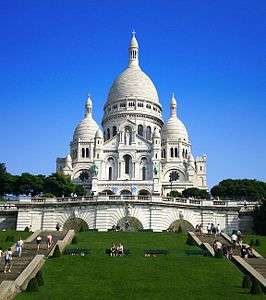 The Basilica of Sacré-Cœur, as seen from the base of the butte Montmartre | |
| Religion | |
| Affiliation | Roman Catholic |
| Province | Archdiocese of Paris |
| Ecclesiastical or organizational status | Minor basilica |
| Year consecrated | 1919 |
| Location | |
| Location | Paris, France |
| Geographic coordinates | 48°53′12.1″N 2°20′34.8″E |
| Architecture | |
| Architect(s) | Paul Abadie |
| Groundbreaking | 1875 |
| Completed | 1914 |
| Specifications | |
| Length | 85 metres (279 ft) |
| Width | 35 metres (115 ft) |
| Height (max) | 83 metres (272 ft) |
| Materials | Travertine stone |
| Website | |
| Basilica of the Sacré Cœur | |
The basilica was designed by Paul Abadie. Construction began in 1875 and was completed in 1914. The basilica was consecrated after the end of World War I in 1919.
Basilica
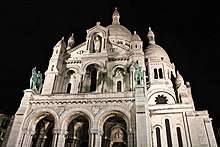
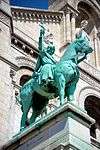
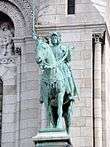
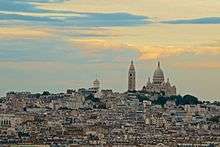
The inspiration for Sacré-Cœur's design originated on 4 September 1870, the day of the proclamation of the Third Republic, with a speech by Bishop Fournier attributing the defeat of French troops during the Franco-Prussian War to a divine punishment after "a century of moral decline" since the French Revolution, in the wake of the division in French society that arose in the decades following that revolution, between devout Catholics and legitimist royalists on one side,[4] and democrats, secularists, socialists, and radicals on the other. This schism in the French social order became particularly pronounced after the 1870 withdrawal of the French military garrison protecting the Vatican in Rome to the front of the Franco-Prussian War by Napoleon III,[5] the secular uprising of the Paris Commune of 1870-1871, and the subsequent 1871 defeat of France in the Franco-Prussian War.
Though today the basilica is asserted[6] to be dedicated in honor of the 58,000 who lost their lives during the war, the decree of the Assemblée nationale 24 July 1873, responding to a request by the archbishop of Paris and voting its construction, specifies that it is to "expiate the crimes of the Commune."[7] Montmartre had been the site of the Commune's first insurrection, and the Communards had executed Georges Darboy, Archbishop of Paris, who became a martyr for the resurgent Catholic Church. His successor Guibert, climbing the Butte Montmartre in October 1872, was reported to have had a vision as clouds dispersed over the panorama: "It is here, it is here where the martyrs are,[8] it is here that the Sacred Heart must reign so that it can beckon all to come."[9]
In the moment of inertia following the resignation of the government of Adolphe Thiers, 24 May 1873, François Pie, bishop of Poitiers, expressed the national yearning for spiritual renewal— "the hour of the Church has come"—[10] that would be expressed through the "Government of Moral Order" of the Third Republic, which linked Catholic institutions with secular ones, in "a project of religious and national renewal, the main features of which were the restoration of monarchy and the defense of Rome within a cultural framework of official piety,"[11] of which Sacré-Cœur is the chief lasting, triumphalist[12] monument.
The 24 July decree voting its construction as a "matter of public utility"[13] followed close on Thiers' resignation. The project was expressed by the Church as a National Vow (Vœu national) and financial support came from parishes throughout France. The dedicatory inscription records the basilica as the accomplishment of a vow by Alexandre Legentil and Hubert Rohault de Fleury, ratified by Joseph-Hippolyte Guibert, Archbishop of Paris. The project took many years to complete.
Construction
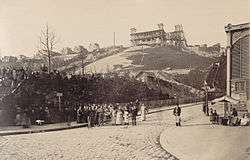
A law of public utility was passed to seize land at the summit of Montmartre for the construction of the basilica. Architect Paul Abadie designed the basilica after winning a competition over 77 other architects.[14] With delays in assembling the property, the foundation stone was finally laid 16 June 1875. Passionate debates concerning the basilica were raised in the Conseil Municipal in 1880, where the basilica was called "an incessant provocation to civil war" and it was debated whether to rescind the law of 1873 granting property rights, an impracticable proposition. The matter reached the Chamber of Deputies in the summer of 1882, in which the basilica was defended by Archbishop Guibert while Georges Clemenceau argued that it sought to stigmatize the Revolution. The law was rescinded but the basilica was saved by a technicality, and the bill was not reintroduced in the next session. A further attempt to halt the construction was defeated in 1897, by which time the interior was substantially complete and had been open for services for six years.[15]

Abadie died not long after the foundation had been laid, in 1884, and five architects continued with the work: Honoré Daumet (1884–1886), Jean-Charles Laisné (1886–1891), Henri-Pierre-Marie Rauline (1891–1904), Lucien Magne (1904–1916), and Jean-Louis Hulot (1916–1924). The basilica was not completed until 1914, when war intervened; it was formally dedicated in 1919 after World War I, when its national symbolism had shifted.
Construction costs, estimated at 7 million French francs and drawn entirely from private donations, were expended before any above-ground, visible structure was to be seen. A provisional chapel was consecrated 3 March 1876, and pilgrimage donations quickly became the mainstay of funding.[16] Donations were encouraged by the expedient of permitting donors to "purchase" individual columns or other features as small as a brick.[17] It was declared by the National Assembly that the state had the ultimate responsibility for funding.
Muted echoes of the basilica's "tortured history" are still heard, geographer David Harvey has noted.[18] In February 1971 demonstrators pursued by the police took refuge in the basilica and called upon their radical comrades to join them in occupying the church "built upon the bodies of communards in order to efface that red flag that had for too long floated over Paris" as their leaflets expressed it.
- Certificat de don pour la souscription nationale de l'édification du Sacré-Cœur à Montmartre (Paris), 1873.
 Construction du Sacré-Cœur, 1882.
Construction du Sacré-Cœur, 1882.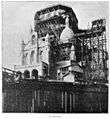 Construction du Sacré-Cœur, 1897.
Construction du Sacré-Cœur, 1897.- Vers 1905.
_(14587477650).jpg) Le Sacré-Cœur du temps des oblats de Marie-Immaculée
Le Sacré-Cœur du temps des oblats de Marie-Immaculée
Architecture
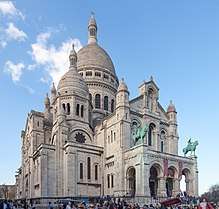
The overall style of the structure shows a free interpretation of Romano-Byzantine features, an unusual architectural vocabulary at the time, which was a conscious reaction against the neo-Baroque excesses of the Palais Garnier cited in the competition.[19] Many design elements of the basilica symbolise nationalist themes: the portico, with its three arches, is adorned by two equestrian statues of French national saints Joan of Arc (1927) and King Saint Louis IX, both executed in bronze by Hippolyte Lefèbvre; and the nineteen-ton Savoyarde bell (one of the world's heaviest), cast in 1895 in Annecy, alludes to the annexation of Savoy in 1860.
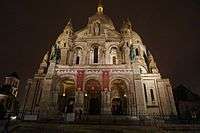
Sacré-Cœur is built of travertine stone quarried in Château-Landon (Seine-et-Marne), France.
A mosaic in the apse entitled Christ in Majesty, created by Luc-Olivier Merson, is among the largest in the world.[20]
The basilica complex includes a garden for meditation, with a fountain. The top of the dome is open to tourists and affords a spectacular panoramic view of the city of Paris, which is mostly to the south of the basilica.
The use of cameras and video recorders is forbidden inside the basilica.
Pipe organ
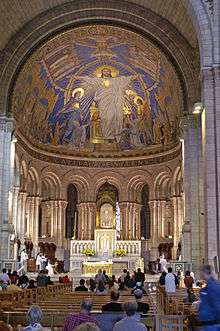
The basilica is home to a large and very fine pipe organ built by Aristide Cavaillé-Coll for a private home in Biarritz, composed of 109 ranks and 78 speaking stops spread across four 61-note manuals and the 32-note pedalboard (unusual before the start of the 20th century; the standard of the day was 56 and 30), spread across three expressive divisions (also unusual for the time, even in large organs). The organ was ahead of its time, containing multiple expressive divisions and giving the performer considerable advantages over other even larger instruments of the day. It was almost identical (tonal characteristics, layout, and casework) to the instrument in Sheffield's Albert Hall, destroyed by fire in 1937. However, when installed in Paris in 1905 by Cavaillé-Coll's successor and son-in-law, Charles Mutin, it lost its ornate case for a much plainer one.[21]
Bells
The belfry of the basilica of the Sacred Heart of Montmartre houses 5 bells, 4 small ones and a huge bourdon called "The Savoyarde", the biggest bell in France. It was cast on May 13, 1891 by the Paccard foundry (Dynasty of Georges, Hippolyte-Francisque and Victor (or G & F)) in Annecy-le-Vieux .
This bell is the fifth largest in Europe behind the Petersglocke of Cologne (Germany), the Olympic bell of London, Maria Dolens of Rovereto (Italy), and the Pummerin of Vienna (Austria), weighs 18,835 kg, measures 3,03 m of diameter for 9.60 m of outer circumference, with a base thickness of 22 cm and a leaf of 850 kg. With its accessories, its official weight reaches 19,685 kg. It was offered by the four dioceses of Savoy and the arrival of the fardier at the Basilica of the Sacred Heart on October 16, 1895, pulled by a team of 28 horses. It rang only for major religious holidays, especially on Easter, Pentecost, Ascension, Christmas, the Assumption and All Saints' Day; it could be heard 10 km away. However, since the late 1990s, a crack has appeared.
Role in Catholicism
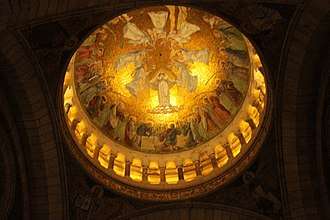
In response to requests from French bishops, Pope Pius IX promulgated the feast of the Sacred Heart in 1856. The basilica itself was consecrated on 16 October 1919.
Since 1885 (before construction had been completed) the Blessed Sacrament (Christ's body, consecrated during the Mass) has been continually on display in a monstrance above the high altar. Perpetual adoration of the Blessed Sacrament has continued uninterrupted in the basilica since 1885. Tourists and others are asked to dress appropriately when visiting the basilica and to observe silence as much as possible, so as not to disturb persons who have come from around the world to pray in this place of pilgrimage, especially since there is the exposition of the Blessed Sacrament. Photos are not allowed to be taken in the Basilica.
Access
The basilica is accessible by bus. Buses 30, 31, 80, and 85 can be taken to the bottom of the hill of the basilica. Line 12 of the metro can be taken to Jules Joffrin station and visitors can then change to the Montmartrobus and disembark at Place du Tertre. Line 2 or 12 of the metro can be taken to Pigalle station where visitors can change to the Montmartrobus and disembark at Norvins, or to Anvers station which gives easy access to the steps or the funicular car that lead directly to the basilica. The Abbesses (Paris Metro) station could be a good choice as well, but is not wheelchair accessible.
Sacré-Cœur is open from 06:00 to 22:30 every day. The dome is accessible from 09:00 to 19:00 in the summer and to 18:00 in the winter.[22]
Copy in Martinique
A much smaller version of the basilica, Sacré-Cœur de la Balata, is located north of Fort-de-France, Martinique, on N3, the main inland road. Built for the refugees driven from their homes by the eruption of Mount Pelée, it was dedicated in 1915.[23]
See also
- Saint Margaret Mary Alacoque, seer and promoter of devotion to the Sacred Heart of Jesus
- Blessed Mary of the Divine Heart, promoter of the world consecration to the Sacred Heart of Jesus
- Church of the Sacred Heart of Jesus, a great shrine dedicated to the worship of the Sacred Heart of Jesus
- Sanctuary of Christ the King, the Portuguese national shrine of the Sacred Heart of Jesus
References
- "Paris monuments". Paris Digest. 2018. Retrieved 2018-09-07.
- An amendment that would have specified that the undertaking "was not solely a protestation of the taking up of arms by the Commune, but a sign of appeasement and concord" was rejected. (David Harvey, "Monument and Myth" Annals of the Association of American Geographers 69.3 (September 1979, pp. 362–381) p 377).
- Raymond Anthony Jonas, France and the cult of the Sacred Heart: an epic tale for modern times, (University of California) 2000, ch. "Building the Church of the National Vow".
- Marguerite Marie Alacoque, the evangelist for veneration of the Sacred Heart, was beatified by Pope Pius IX in 1864.
- "The Origin of the Construction of the Basilica, A "National Vow"". Basilique du Sacré-Cœur. Retrieved 2 July 2017.
- "Hotels in Paris Close to : Basilica of Sacré Coeur - Secure Booking - Free Cancellation". France Hotel Guide. Retrieved 2017-05-20.
- "N° 1262 - Rapport d'information de M. Bernard Accoyer fait au nom de la mission d'information sur les questions mémorielles". www.assemblee-nationale.fr. Retrieved 2017-05-20.
- General Claude Lecomte and General Clément-Thomas, shot by insurrectionists in the early days of the Commune, in the garden of 6, rue des Rosiers. (Harvey "Monument and Myth" 1979, P 370).
- Reported in the history of the construction to 1890, written from a dedicated Catholic perspective, by R. P. Jonquet, Montmartre Autrefois et Aujourd’hui (Paris: Dumoulin) 1890; quoted by Harvey "Monument and Myth" 1979, P364.
- Louis Baunard, Histoire du cardinal Pie 1886, vol. II:498, quoted in Raymond A. Jonas, "Monument as Ex-Voto, Monument as Historiosophy: The Basilica of Sacre-Coeur" French Historical Studies 18.2 (Autumn 1993, pp. 482–502) p. 483.
- Jonas 1993:485
- "The reaction to the communes of Paris and Lyon were triumphalist monuments, the Sacré-Cœur of Montmartre and the basilica of Fourvière, dominating both cities. These buildings were erected using private funds, as gigantic ex-votos, thanking God for the victory over the socialists and in expiation of the sins of modern France." (Bertrand Taithe, Citizenship and Wars: France in Turmoil, 1870–1871, chapter "Religious Identities and Citizenship" 2001:100).
- According to its minutes; 23 July according to the dedicatory inscription in the Basilica.
- The competition was commemorated in Souvenir du Concours de l’Église du Sacré-Cœur (Paris: J. Le Clere) 1874.
- Harvey "Monument and Myth" 1979, pp 380–81 .
- In 1877, its first full year of operation, visiting pilgrims dropped over 240,000 francs into the collection boxes; the figure doubled the following year. (Jonas 1993:495).
- This fund-raising technique, originated at Sacré-Cœur, became standard practice for funding cultural institutions' building projects in Europe and the Americas after World War I.
- Harvey "Monument and Myth" 1979, P381 .
- Legentil had wanted to demolish the half-built opera house and build triumphantly on the site of that "scandalous monument of extravagance, indecency and bad taste" (Harvey "Monument and Myth" 1979, P376 ).
- http://www.sacre-coeur-montmartre.com/english/history-and-visit/article/the-apse-mosaic Apse Mosaic
- "Basilique Sacré-Coeur". Université du Québec. Archived from the original on 2 February 2009.
- "Opening Hours for the Visit". Basilique du Sacré-Cœur. Retrieved 2 July 2017.
- "Uncommon Attraction: Sacré-Coeur de la Balata". Uncommon Caribbean. Martinique.
Further reading
| Wikimedia Commons has media related to Basilique du Sacré-Cœur de Montmartre. |
- Jacques Benoist, Le Sacre-Coeur de Montmartre de 1870 a nos Jours (Paris) 1992. A cultural history from the point of view of a former chaplain.
- Yvan Crist, "Sacré-Coeur" in Larousse Dictionnaire de Paris (Paris) 1964.
- David Harvey. Consciousness and the Urban Experience: Studies in the History and Theory of Capitalist Urbanization. (Baltimore: The Johns Hopkins University Press) 1985.
- David Harvey."The building of the Basilica of Sacré-Coeur", coda to Paris, Capital of Modernity (2003:311ff) Harvey made use of Hubert Rohault de Fleury. Historique de la Basilique du Sacré Coeur (1903–09), the official history of the building of the Basilica, in four volumes, printed, but not published.
- Raymond A. Jonas. “Sacred Tourism and Secular Pilgrimage: and the Basilica of Sacré-Coeur”. in Montmartre and the Making of Mass Culture. Gabriel P. Weisberg, editor. (New Brunswick, NJ: Rutgers University Press) 2001.
